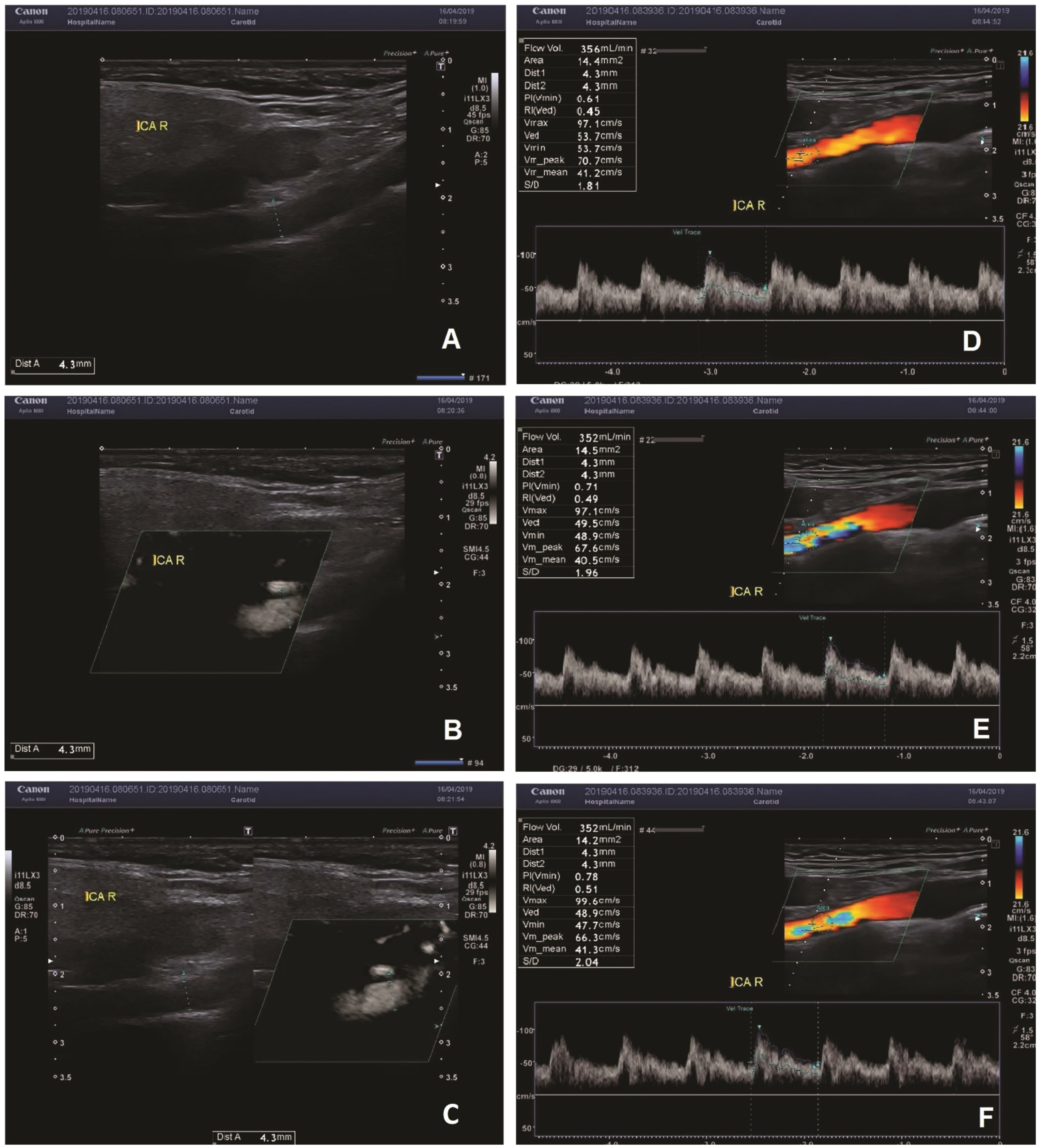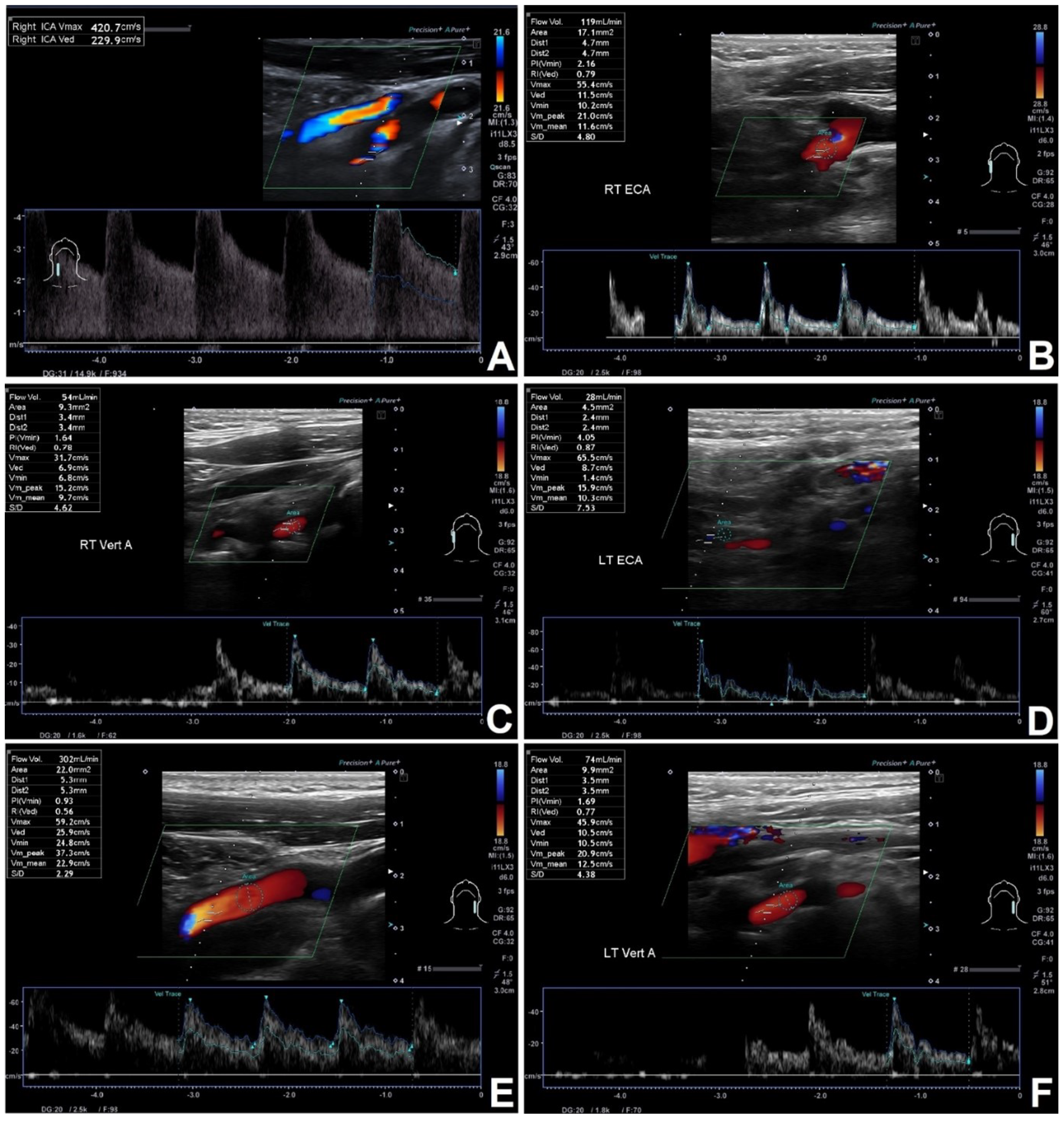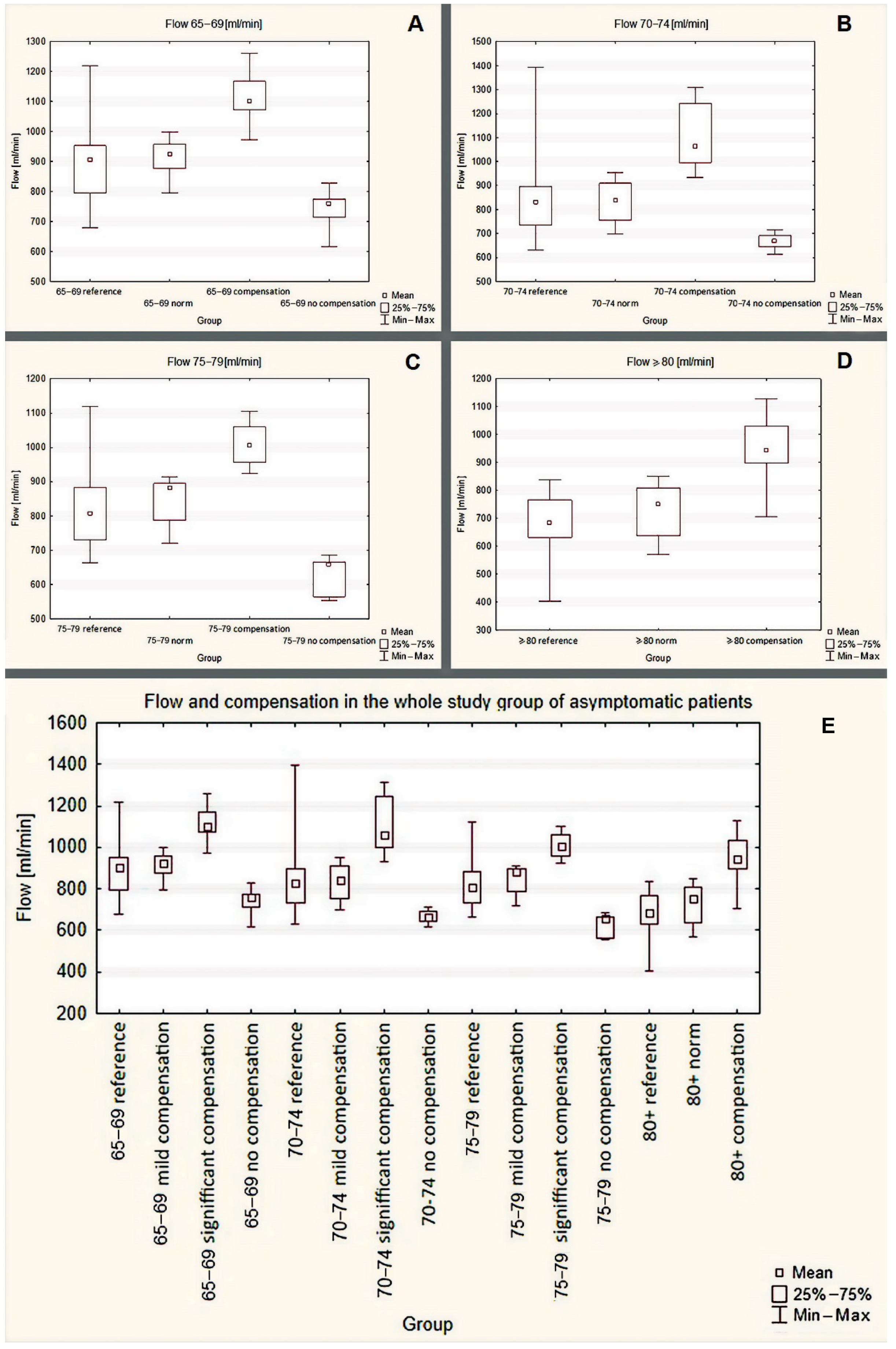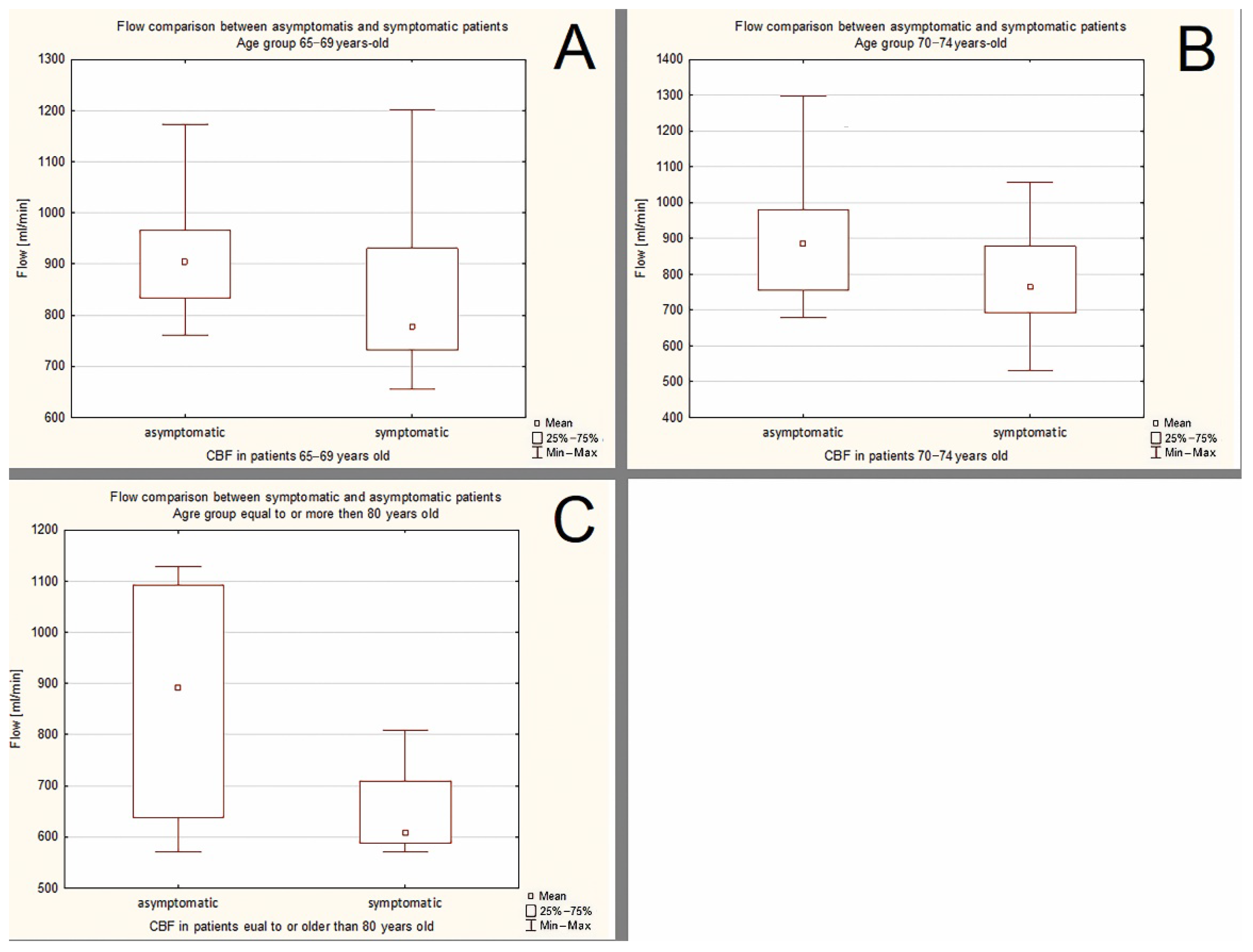Volumetric Flow Assessment in Doppler Ultrasonography in Risk Stratification of Patients with Internal Carotid Stenosis and Occlusion
Abstract
1. Introduction
2. Materials and Methods
3. Results
3.1. CBF Reference Values
3.2. CBF in Asymptomatic Patients with ≥50% ICA Stenosis
- Patients with elevated CBF as a result of multivessel significant flow increase (57/154);
- Patients with less pronounced compensation (mild compensation) in other extracranial arteries, which results in CBF within proposed reference standard for healthy population (67/154);
- Patients with lower CBF than the proposed reference standards (30/154).
3.2.1. CBF in the Group with 50–69% ICA Stenosis
3.2.2. CBF in the Group with 70–99% ICA Stenosis
3.2.3. CBF in the Group with ICA Occlusion
3.2.4. CBF in Merged Group ICA 70–99% Stenosis + ICA Occlusion
3.3. Comparison of the Flow Volume Values and Flow Changes in Asymptomatic Patients ≥50% ICA Stenosis
3.4. Pathways of Volumetric Flow Compensation in the Group of Asymptomatic Patients with ≥50% ICA Stenosis
3.5. CBF in Symptomatic Patients Referred for Surgical Treatment
3.6. CBF Comparison in Patients with ≥70% ICA Stenosis: Asymptomatic Group and Symptomatic, Referred for Surgical Treatment
4. Discussion
5. Conclusions
Author Contributions
Funding
Institutional Review Board Statement
Informed Consent Statement
Conflicts of Interest
References
- Aboyans, V.; Ricco, J.-B.; Bartelink, M.-L.E.L.; Björck, M.; Brodmann, M.; Cohnert, T.; Naylor, A.R.; Roffi, M.; Tendera, M.; Vlachopoulos, C.; et al. Editor’s Choice—2017 ESC Guidelines on the Diagnosis and Treatment of Peripheral Arterial Diseases, in collaboration with the European Society for Vascular Surgery (ESVS). Eur. J. Vasc. Endovasc. Surg. 2018, 55, 305–368. [Google Scholar] [CrossRef]
- Gupta, A.; Chazen, J.; Hartman, M. Cerebrovascular Reserve and Stroke Risk in Patients with Carotid Stenosis or Occlusion: A Systematic Review and Meta-Analysis. J. Vasc. Surg. 2013, 57, 1720. [Google Scholar] [CrossRef][Green Version]
- Sobczyk, O.; Sam, K.; Mandell, D.M.; Crawley, A.P.; Venkatraghavan, L.; McKetton, L.; Poublanc, J.; Duffin, J.; Fisher, J.A.; Mikulis, D.J. Cerebrovascular Reactivity Assays Collateral Function in Carotid Stenosis. Front. Physiol. 2020, 11, 1031. [Google Scholar] [CrossRef]
- Bang, O.Y.; Saver, J.L.; Buck, B.H.; Alger, J.R.; Starkman, S.; Ovbiagele, B.; Kim, D.; Jahan, R.; Duckwiler, G.R.; Yoon, S.R.; et al. Impact of collateral flow on tissue fate in acute ischaemic stroke. J. Neurol. Neurosurg. Psychiatry 2008, 79, 625–629. [Google Scholar] [CrossRef]
- Sheth, S.A.; Sanossian, N.; Hao, Q.; Starkman, S.; Ali, L.K.; Kim, O.; Gonzalez, N.R.; Tateshima, S.; Jahan, R.; Duckwiler, G.R.; et al. Collateral flow as causative of good outcomes in endovascular stroke therapy. J. NeuroInterv. Surg. 2014, 8, 2–7. [Google Scholar] [CrossRef]
- Tan, B.; Wan-Yee, K.; Paliwal, P.; Gopinathan, A.; Nadarajah, M.; Ting, E.; Venketasubramanian, N.; Seet, R.C.; Chan, B.P.; Teoh, H.L.; et al. Good Intracranial Collaterals Trump Poor ASPECTS (Alberta Stroke Program Early CT Score) for Intravenous Thrombolysis in Anterior Circulation Acute Ischemic Stroke. Stroke 2016, 47, 2292–2298. [Google Scholar] [CrossRef] [PubMed]
- Lattanzi, S.; Carbonari, L.; Pagliariccio, G.; Bartolini, M.; Cagnetti, C.; Viticchi, G.; Buratti, L.; Provinciali, L.; Silvestrini, M. Neurocognitive functioning and cerebrovascular reactivity after carotid endarterectomy. Neurology 2018, 90, e307–e315. [Google Scholar] [CrossRef] [PubMed]
- Lattanzi, S.; Carbonari, L.; Pagliariccio, G.; Cagnetti, C.; Luzzi, S.; Bartolini, M.; Buratti, L.; Provinciali, L.; Silvestrini, M. Predictors of cognitive functioning after carotid revascularization. J. Neurol. Sci. 2019, 405, 116435. [Google Scholar] [CrossRef] [PubMed]
- North American Symptomatic Carotid Endarterectomy Trial Collaborators; Barnett, H.J.M.; Taylor, D.W.; Haynes, R.B.; Sackett, D.L.; Peerless, S.J.; Ferguson, C.G.; Fox, A.J.; Rankin, R.N.; Hachinski, V.C.; et al. Beneficial effect of carotid endarterectomy in symptomatic patients with high-grade carotid stenosis. N. Engl. J. Med. 1991, 325, 445–453. [Google Scholar] [CrossRef]
- MRC Asymptomatic Carotid Surgery Trial (ACST) Collaborative Group. Prevention of disabling and fatal strokes by successful carotid endarterectomy in patients without recent neurological symptoms: Randomised controlled trial. Lancet 2004, 363, 1491–1502. [Google Scholar] [CrossRef]
- Howard, V.J.; Meschia, J.F.; Lal, B.K.; Turan, T.N.; Roubin, G.S.; Brown, R.D., Jr.; Voeks, J.H.; Barrett, K.M.; Demaerschalk, B.M.; Huston, I.J.; et al. Carotid revascularization and medical management for asymptomatic carotid stenosis: Protocol of the CREST-2 clinical trials. Int. J. Stroke 2017, 12, 770–778. [Google Scholar] [CrossRef]
- Kaszczewski, P.; Elwertowski, M.; Leszczynski, J.; Ostrowski, T.; Galazka, Z. Volumetric Carotid Flow Characteristics in Doppler Ultrasonography in Healthy Population Over 65 Years Old. J. Clin. Med. 2020, 9, 1375. [Google Scholar] [CrossRef]
- Elwertowski, M.; Leszczyński, J.; Kaszczewski, P.; Lamparski, K.; Yee Ho, S.S.; Gałązka, Z. The importance of blood flow volume in the brain-supplying arteries for the clinical management—the impact of collateral circulation. J. Ultrason. 2018, 18, 112–119. [Google Scholar] [CrossRef]
- Grant, E.G.; Benson, C.B.; Moneta, G.L.; Alexandrov, A.V.; Baker, J.D.; Bluth, E.I.; Carroll, B.A.; Eliasziw, M.; Gocke, J.; Hertzberg, B.S.; et al. Carotid Artery Stenosis: Gray-Scale and Doppler US Diagnosis—Society of Radiologists in Ultrasound Consensus Conference. Radiology 2003, 229, 340–346. [Google Scholar] [CrossRef] [PubMed]
- von Reutern, G.M.; Goertler, M.W.; Bornstein, N.M.; Sette, M.D.; Evans, D.H.; Goertler, M.W.; Hetzel, A.; Kaps, M.; Perren, F.; Razumovky, A.; et al. Grading carotid stenosis using ultrasonic methods. Stroke 2012, 43, 916–921. [Google Scholar] [CrossRef] [PubMed]
- Arning, C.; Widder, B.; von Reutern, G.M.; Stiegler, H.; Görtler, M. Revision of DEGUM ultrasound criteria for grading internal carotid artery stenoses and transfer to NASCET measurement. Ultraschall Med. 2010, 31, 251–257. [Google Scholar] [CrossRef]
- Romero, J.R.; Pikula, A.; Nguyen, T.N.; Nien, Y.L.; Norbash, A.; Babikian, V.L. Cerebral collateral circulation in carotid artery disease. Curr. Cardiol. Rev. 2009, 5, 279–288. [Google Scholar] [CrossRef] [PubMed]
- Mozaffarian, D.; Benjamin, E.J.; Go, A.S.; Arnett, D.K.; Blaha, M.J.; Cushman, M.; Das, S.R.; De Ferranti, S.; Després, J.P.; Fullerton, H.J.; et al. Executive summary: Heart disease and stroke statistics—2016 update: A report from the American Heart Association. Circulation 2016, 133, 447–454. [Google Scholar] [CrossRef]
- Amarenco, P.; Lavallée, P.C.; Tavares, L.M.; Labreuche, J.; Albers, G.W.; Abboud, H.; Anticoli, S.; Audebert, H.; Bornstein, N.M.; Caplan, L.R.; et al. Five-Year Risk of Stroke after TIA or Minor Ischemic Stroke. N. Engl. J. Med. 2018, 378, 2182–2190. [Google Scholar] [CrossRef]
- Reinhard, M.; Schwarzer, G.; Briel, M.; Altamura, C.; Palazzo, P.; King, A.; Bornstein, N.M.; Petersen, N.; Motschall, E.; Hetzel, A.; et al. Cerebrovascular reactivity predicts stroke in high-grade carotid artery disease. Neurology 2014, 83, 1424–1431. [Google Scholar] [CrossRef] [PubMed]
- Fisher, J.A.; Venkatraghavan, L.; Mikulis, D.J. Magnetic Resonance Imaging–Based Cerebrovascular Reactivity and Hemodynamic Reserve. Stroke 2018, 49, 2011–2018. [Google Scholar] [CrossRef]
- Lee, R.M. Morphology of cerebral arteries. Pharmacol. Ther. 1995, 66, 149–173. [Google Scholar] [CrossRef]
- Szabo, K.; Kern, R.; Gass, A.; Hirsch, J.; Hennerici, M. Acute stroke patterns in patients with internal carotid artery disease: A diffusion-weighted magnetic resonance imaging study. Stroke 2001, 32, 1323–1329. [Google Scholar] [CrossRef]
- Jongen, L.M.; Van Der Worp, H.B.; Waaijer, A.; Van Der Graaf, Y.; Mali, W.P.T.M. Interrelation between the Degree of Carotid Stenosis, Collateral Circulation and Cerebral Perfusion. Cerebrovasc. Dis. 2010, 30, 277–284. [Google Scholar] [CrossRef]
- Sterpetti, A.V.; Schultz, R.D.; Feldhaus, R.J. External carotid endarterectomy: Indications, technique, and late results. J. Vasc. Surg. 1988, 7, 31–39. [Google Scholar] [CrossRef][Green Version]
- Fields, W.S.; Brustrnan, M.E.; Wribel, J. Collateral circulation of the brain. Monogr. Surg. Sci. 1965, 2, 183–259. [Google Scholar]
- Zarins, C.K.; DelBeccaro, E.J.; Johns, L.; Turcotte, J.K.; Dohrmann, G.J. Increased cerebral blood flow after external carotid artery revascularization. Surgery 1981, 89, 730–734. [Google Scholar]
- Powers, W.J. Cerebral hemodynamics in ischemic cerebrovascular disease. Ann. Neurol. 1991, 29, 231–240. [Google Scholar] [CrossRef]
- Symon, L.; Ishikawa, S.; Meyer, J.S. Cerebral arterial pressure changes and development of leptomeningeal collateral circulation. Neurology 1963, 13, 237. [Google Scholar] [CrossRef]
- Iwasawa, E.; Ichijo, M.; Ishibashi, S.; Yokota, T. Acute development of collateral circulation and therapeutic prospects in ischemic stroke. Neural Regen. Res. 2016, 11, 368–371. [Google Scholar] [CrossRef] [PubMed]
- Adamczak, J.; Hoehn, M. Poststroke Angiogenesis, Con Dark Side of Angiogenesis. Stroke 2015, 46, e103–e104. [Google Scholar] [CrossRef]
- Calogero, E.; Fabiani, I.; Pugliese, N.R.; Santini, V.; Ghiadoni, L.; Di Stefano, R.; Galetta, F.; Sartucci, F.; Penno, G.; Berchiolli, R.; et al. Three-dimensional echographic evaluation of carotid artery disease. J. Cardiovasc. Echogr. 2018, 28, 218–227. [Google Scholar] [CrossRef]
- Makris, G.C.; Lavida, A.; Griffin, M.; Geroulakos, G.; Nicolaides, A.N. Three-dimensional ultrasound imaging for the evaluation of carotid atherosclerosis. Atherosclerosis 2011, 219, 377–383. [Google Scholar] [CrossRef]
- Hossain, M.M.; Almuhanna, K.; Zhao, L.; Lal, B.K.; Sikdar, S. Semiautomatic segmentation of atherosclerotic carotid artery wall volume using 3D ultrasound imaging. Med. Phys. 2015, 42, 2029–2043. [Google Scholar] [CrossRef] [PubMed]
- Kripfgans, O.D.; Pinter, S.Z.; Baiu, C.; Bruce, M.F.; Carson, P.L.; Chen, S.; Erpelding, T.N.; Gao, J.; Lockhart, M.E.; Milkowski, A.; et al. Three-dimensional US for Quantification of Volumetric Blood Flow: Multisite Multisystem Results from within the Quantitative Imaging Biomarkers Alliance. Radiology 2020, 296, 662–670. [Google Scholar] [CrossRef] [PubMed]
- Henderson, R.D.; Eliasziw, M.; Fox, A.J.; Rothwell, P.M.; Barnett, H.J.M. Angiographically Defined Collateral Circulation and Risk of Stroke in Patients with Severe Carotid Artery Stenosis. North American Symptomatic Carotid Endarterectomy Trial (NASCET) Group. Stroke 2000, 31, 128–132. [Google Scholar] [CrossRef] [PubMed]





| Group—Age | 65–69 | 70–74 | 75–80 | >80 |
|---|---|---|---|---|
| Proposed reference value (mL/min) | 898.5 ± 119.1 | 838.5 ± 148.9 | 805.1 ± 99.3 | 685.7 ± 112.3 |
| RICA (mL/min) | 271.1 ± 63.6 | 236.0 ± 66.1 | 234.8 ± 62.3 | 202.3 ± 38.4 |
| RECA (mL/min) | 106.1 ± 35.0 | 103.7 ± 33.2 | 94.0 ± 24.14 | 83.1 ± 36.3 |
| RVA (mL/min) | 58.7 ± 29.1 | 60.2 ± 26.7 | 62.3 ± 28.4 | 55.7 ± 24.1 |
| LICA (mL/min) | 276.4 ± 57.5 | 239.8 ± 42.4 | 245.5 ± 32.3 | 204.4 ± 47.0 |
| LECA (mL/min) | 101.4 ± 30.9 | 104.7 ± 32.5 | 89.0 ± 21.9 | 79.0 ± 33.7 |
| LVA (mL/min) | 84.9 ± 33.0 | 80.4 ± 29.8 | 70.0 ± 21.5 | 58.8 ± 13.0 |
| Study Group—Asymptomatic Patients with ICA 50% Stenosis—Occlusion | |||
|---|---|---|---|
| ICA Stenosis (%) | 50–69% | 70–99% | 100%—occlusion of the ICA |
| Number of patients | 66 | 53 | 35 |
| Average age (years) | 72.2 | 73.4 | 71.8 |
| Number of females | 31 | 17 | 11 |
| Number of males | 35 | 36 | 24 |
| Study group—symptomatic patients referred for CEA due to ≥70% ICA stenosis | |||
| Average age (years) | 71.8 | ||
| Number of females | 13 | ||
| Number of males | 18 | ||
| No Compensation | Mild Compensation Resulting in Flow within Proposed Standard for Age | Significant Compensation—Increased Flow Volume | |
|---|---|---|---|
| (Number of Patients) | (Number of Patients) | (Number of Patients) | |
| % of people in 50–69% stenosis group | 13/66—19.7% | 34/66—51.5% | 19/66—28.8% |
| % of people in 70–99% stenosis group | 10/53—18.9% | 17/53—32.1% | 26/53—49% |
| % of people in occlusion group | 7/35—20% | 16/35—45.7% | 12/35—34.3% |
| % of people in stenosis 70–99% + occlusions group | 17/88—19.3% | 33/88—37.5% | 38/88—43.2% |
| Flow Volume (mL/min) Mean 25–75% Min–Max | ||||
|---|---|---|---|---|
| Age Group (Years) | Reference (Healthy Volunteers) | No Compensation | Mild Compensation | Significant Compensation |
| 65–69 | 905.5 | 758 | 923 | 1102,5 |
| 796–953 | 714.5–775.5 | 876–958 | 1073–1167.5 | |
| 679–1220 | 616–828 | 796–999 | 973–1262 | |
| 70–74 | 830 | 667.5 | 839 | 1064 |
| 735–896 | 645–691 | 755–909 | 996–1243 | |
| 630–1394 | 614–715 | 697–953 | 934–1310 | |
| 75–79 | 807 | 650 | 881 | 1005 |
| 730.5–883.5 | 564–665 | 787–895 | 956.5–1060 | |
| 662–1119 | 552–685 | 720–913 | 923–1105 | |
| ≥80 | 684.5 | 1 patient with flow of 555 mL/min (excluded from analysis) | 751 | 943 |
| 631.5–766 | 638–809 | 899–1032 | ||
| 404–838 | 571–851 | 706–1129 | ||
| 65–69 Reference | 65–69 Mild Compensation | 65–69 Signifficant Compensation | 65–69 No Compensation | 70–74 Reference | 70–74 Mild Compensation | 70–74 Signifficant Compensation | 70–74 No Compensation | 75–79 Reference | 75–79 Mild Compensation | 75–79 Signifficant Compensation | 75–79 No Compensation | 80+ Reference | 80+ Mild Compensation | 80+ Signifficant Compensation | |
|---|---|---|---|---|---|---|---|---|---|---|---|---|---|---|---|
| 65–69 reference | 0.9 | 0.002 | 0.000 | 0.008 | 0.025 | 0.000 | 0.000 | 0.002 | 0.100 | 0.007 | 0.000 | 0.000 | 0.000 | 0.62 | |
| 65–69 mild compensation | 0.000 | 0.000 | 0.000 | 0.300 | 0.000 | 0.000 | 0.003 | 0.007 | 0.001 | 0.000 | 0.000 | 0.000 | 0.128 | ||
| 65–69 signifficant compensation | 0.000 | 0.000 | 0.000 | 0.436 | 0.000 | 0.000 | 0.000 | 0.008 | 0.000 | 0.000 | 0.000 | 0.000 | |||
| 65–69 no compensation | 0.018 | 0.019 | 0.000 | 0.004 | 0.040 | 0.004 | 0.000 | 0.004 | 0.125 | 0.730 | 0.000 | ||||
| 70–74 reference | 0.960 | 0.000 | 0.001 | 0.987 | 0.930 | 0.000 | 0.000 | 0.000 | 0.014 | 0.002 | |||||
| 70–74 mild compensation | 0.002 | 0.002 | 0.980 | 0.930 | 0.000 | 0.000 | 0.000 | 0.014 | 0.002 | ||||||
| 70–74 signifficant compensation | 0.000 | 0.000 | 0.000 | 0.130 | 0.001 | 0.000 | 0.000 | 0.012 | |||||||
| 70–74 no compensation | 0.000 | 0.000 | 0.000 | 0.300 | 0.900 | 0.300 | 0.000 | ||||||||
| 75–79 reference | 0.980 | 0.006 | 0.022 | 0.001 | 0.041 | 0.002 | |||||||||
| 75–79 mild compensation | 0.120 | 0.010 | 0.000 | 0.003 | 0.006 | ||||||||||
| 75–79 signifficant compensation | 0.000 | 0.000 | 0.000 | 0.241 | |||||||||||
| 75–79 no compensation | 0.184 | 0.119 | 0.000 | ||||||||||||
| 80+ reference | 1.000 | 0.000 | |||||||||||||
| 80+ mild compensation | 0.000 |
| No Compensation (Number of Patients) | Mild Compensation Resulting in Flow within Proposed Standard for Age (Number of Patients) | Significant Compensation Resulting in Increased Flow Volume (Number of Patients) | |
|---|---|---|---|
| Symptomatic patients with significant ICA stenosis | 11 | 12 | 8 |
| % of the group | 11/31—35.5% | 12/31—39% | 8/31—25.5% |
| Number of strokes | 1 | 4 | 1 |
| Number of TIA | 10 | 8 | 7 |
| Age Group | Clinical Presentation | Mean (mL/min) | 25–75% (mL/min) | Min–Max (mL/min) | p Value |
|---|---|---|---|---|---|
| 65–69 | Asymptomatic | 902.5 | 833.5–965.5 | 761–1172 | p = 0.049 |
| Symptomatic | 777.5 | 732–930.5 | 656–1201 | ||
| 70–74 | Asymptomatic | 884 | 756.5–981 | 679–1298 | p = 0.041 |
| Symptomatic | 763 | 692–878 | 530–1057 | ||
| ≥80 | Asymptomatic | 891.5 | 638–1092 | 571–1129 | p = 0.044 |
| Symptomatic | 607 | 587–709.5 | 570–809 |
Publisher’s Note: MDPI stays neutral with regard to jurisdictional claims in published maps and institutional affiliations. |
© 2022 by the authors. Licensee MDPI, Basel, Switzerland. This article is an open access article distributed under the terms and conditions of the Creative Commons Attribution (CC BY) license (https://creativecommons.org/licenses/by/4.0/).
Share and Cite
Kaszczewski, P.; Elwertowski, M.; Leszczyński, J.; Ostrowski, T.; Gałązka, Z. Volumetric Flow Assessment in Doppler Ultrasonography in Risk Stratification of Patients with Internal Carotid Stenosis and Occlusion. J. Clin. Med. 2022, 11, 531. https://doi.org/10.3390/jcm11030531
Kaszczewski P, Elwertowski M, Leszczyński J, Ostrowski T, Gałązka Z. Volumetric Flow Assessment in Doppler Ultrasonography in Risk Stratification of Patients with Internal Carotid Stenosis and Occlusion. Journal of Clinical Medicine. 2022; 11(3):531. https://doi.org/10.3390/jcm11030531
Chicago/Turabian StyleKaszczewski, Piotr, Michał Elwertowski, Jerzy Leszczyński, Tomasz Ostrowski, and Zbigniew Gałązka. 2022. "Volumetric Flow Assessment in Doppler Ultrasonography in Risk Stratification of Patients with Internal Carotid Stenosis and Occlusion" Journal of Clinical Medicine 11, no. 3: 531. https://doi.org/10.3390/jcm11030531
APA StyleKaszczewski, P., Elwertowski, M., Leszczyński, J., Ostrowski, T., & Gałązka, Z. (2022). Volumetric Flow Assessment in Doppler Ultrasonography in Risk Stratification of Patients with Internal Carotid Stenosis and Occlusion. Journal of Clinical Medicine, 11(3), 531. https://doi.org/10.3390/jcm11030531






